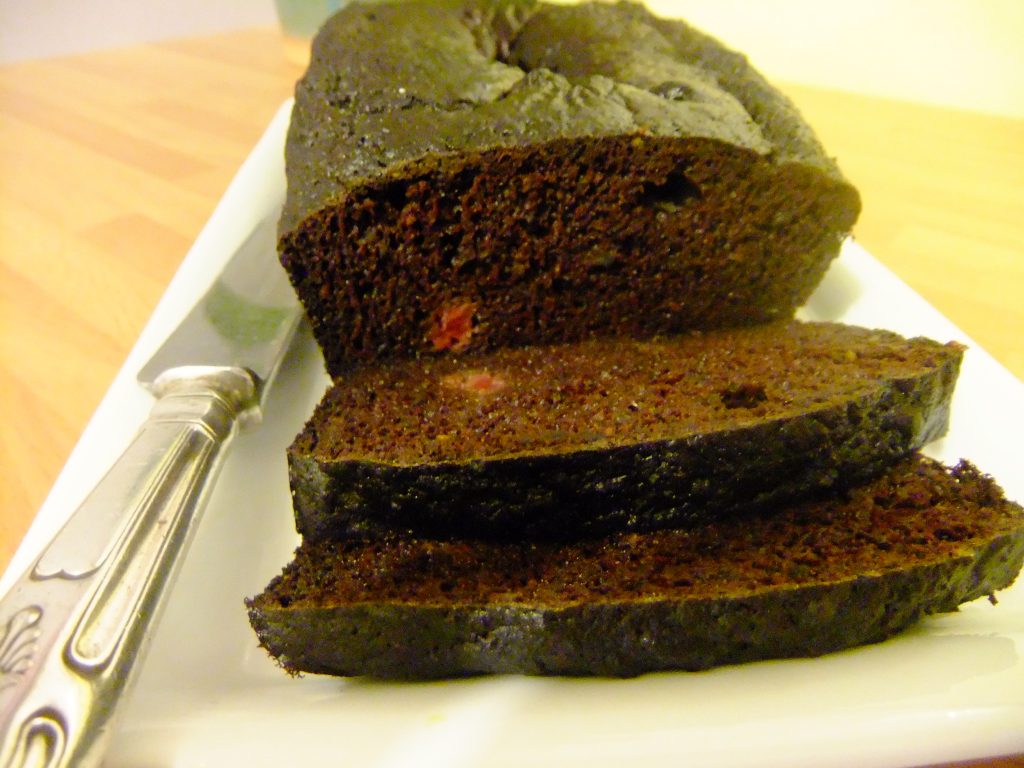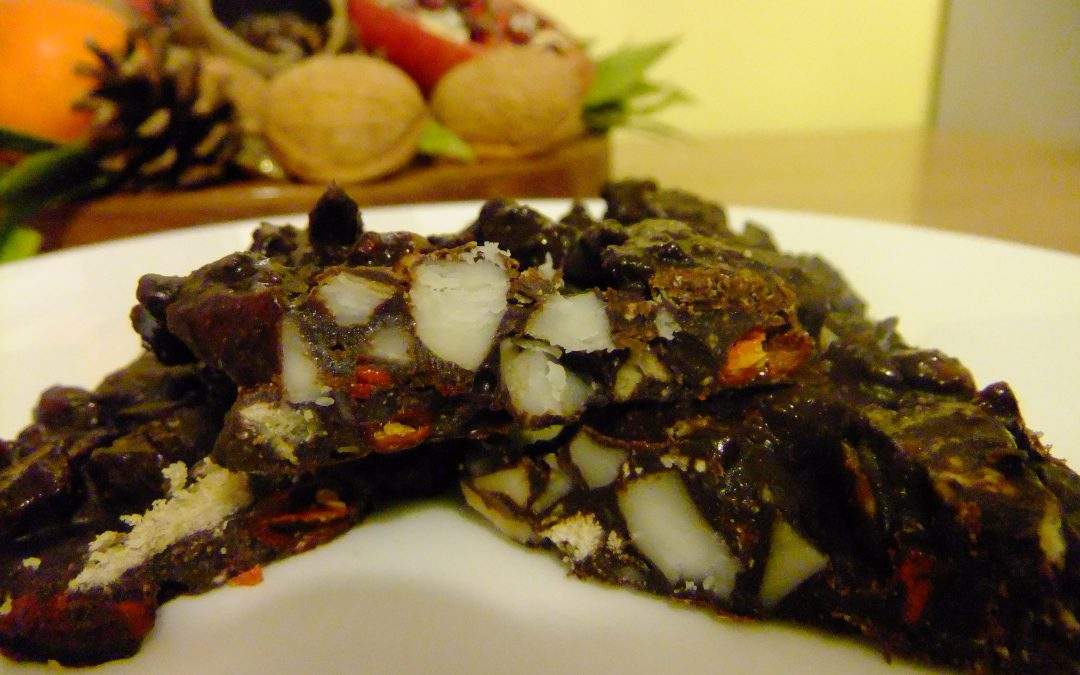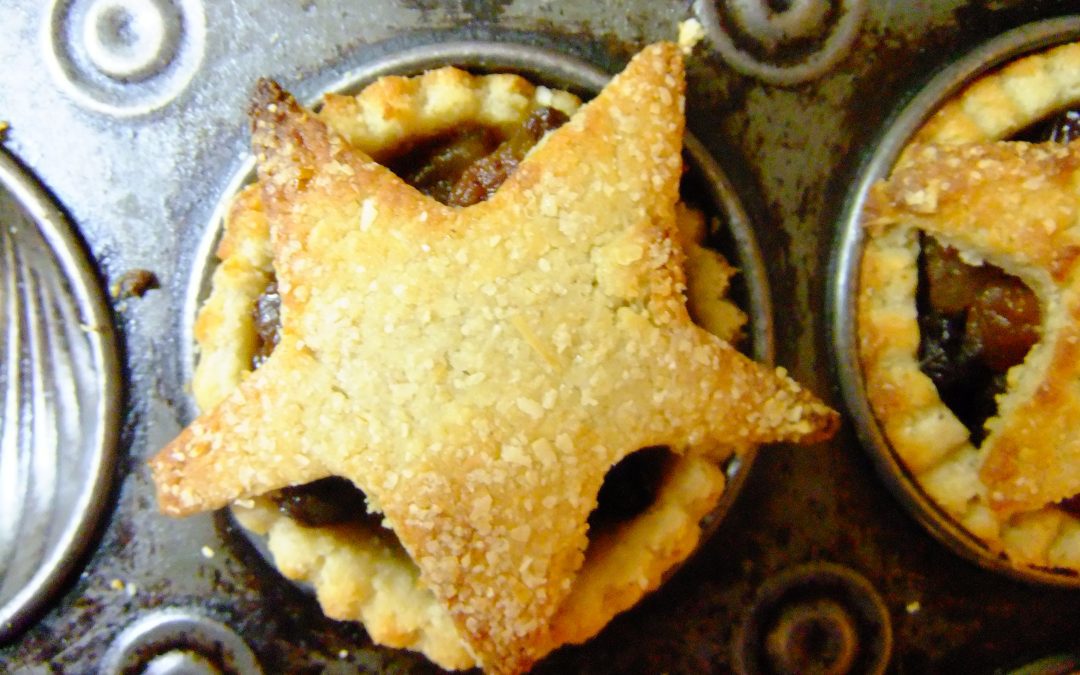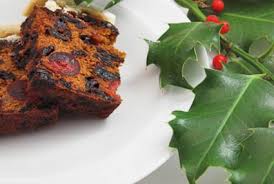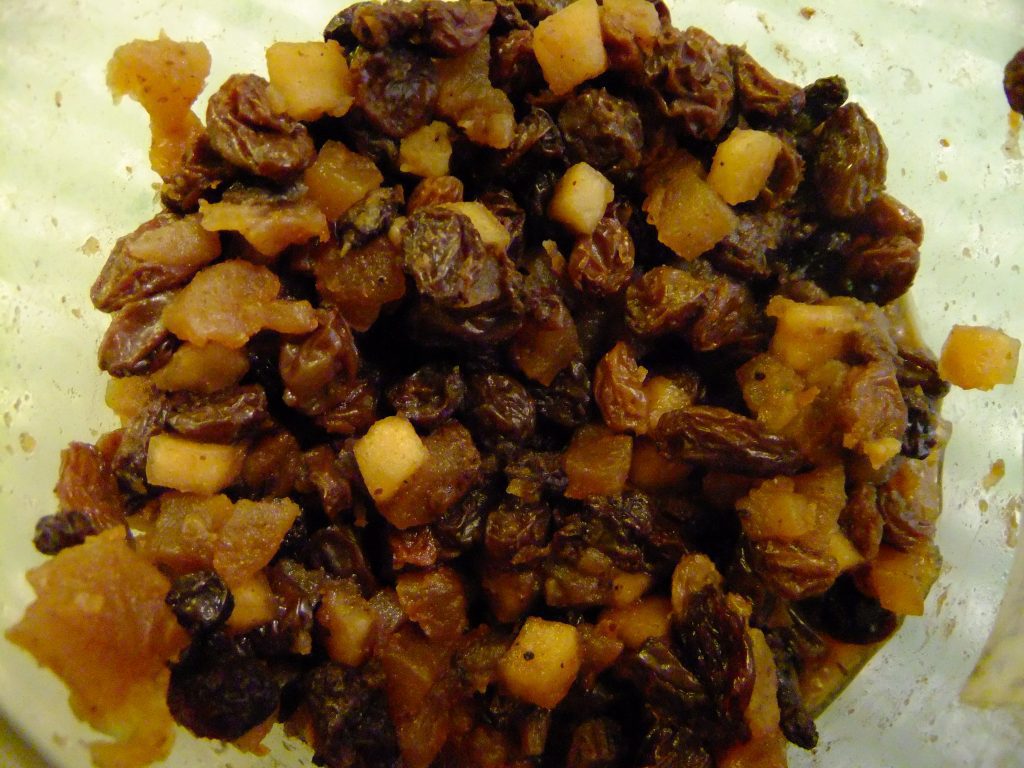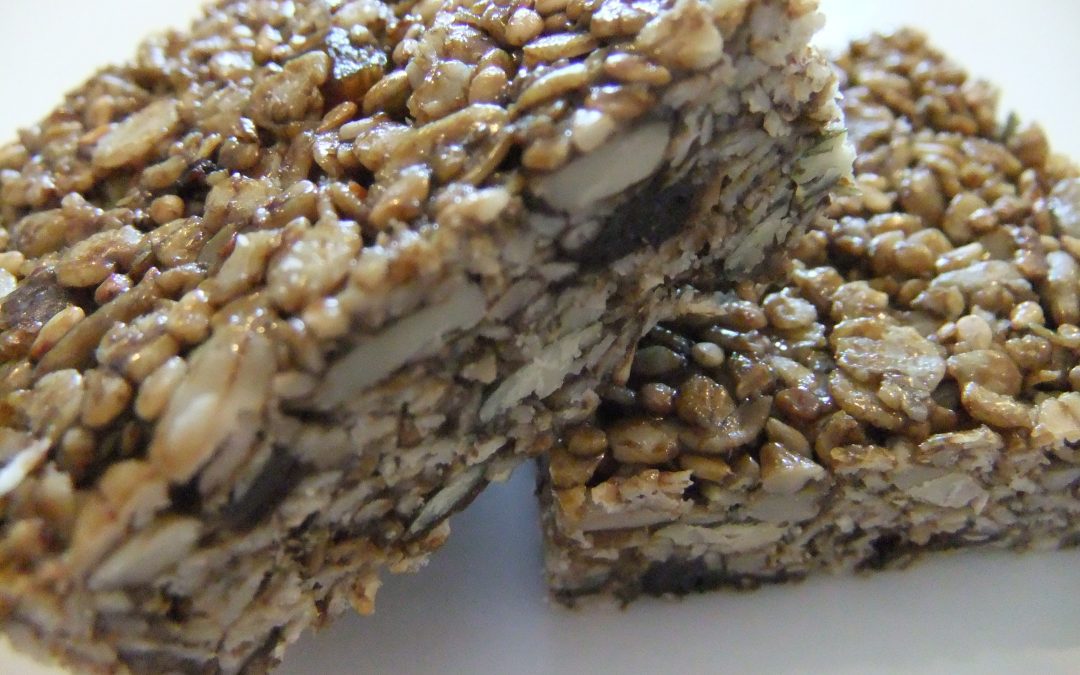
Jul 30, 2014 | Anna's Best Recipes, Cakes, biscuits & bars, Sides, starters, soups & snacks
I made these raw protein bars for snacks a few weeks ago, adapted from Christine Bailey’s recipe. I meant to bring the leftovers in to my nutrition clinic to share with colleagues but somehow we just couldn’t bear to part with them. We ate the lot over the following week. These are quite like the Nakd bars you find in health stores. This bar is perfect when you are short of time and need something to support your blood sugar levels and you want something sweet. These are a good emergency breakfast option, post-gym snack or lunchbox treat. These can be frozen in batches for up to a month.
Makes 12 large bars
For unusual ingredients, don’t forget to check out “larder & shopping”
200g/1½ cups raw Brazil nuts
60g gluten-free organic porridge oats or buckwheat flakes
30g ground chia seeds (buy ready-ground or use a coffee/spice grinder)
250g dried unsulphured apricots, soaked overnight in filtered water/250g dried apricots plus 6 tbs water/freshly squeezed orange juice
3 heaped tbs unsweetened or vanilla protein powder (Nua Naturals rice protein, Nuzest Clean Lean Protein or Sunwarrior Classic/Warrior blend are all great. Solgar Whey-to-go vanilla is another option if eat dairy and are using this snack for sports nutrition/muscle recovery.
Zest of 1 orange, organic if possible
Pinch of Himalayan or Atlantic Sea Salt
Essential equipment: food processor
1. Chop the apricots roughly. If you have not already done so, grind the chia seeds and set aside.
2. Place the nuts and oats in a food processor and process until fine. Add the chia, apricots, protein powder and orange zest and process till well mixed. If you have used soaked apricots this will usually form a dough. If your apricots are unsoaked then you will need to start adding the orange juice or water about 2 tbs at a time, pulsing in between, until the mixture forms a dough. The amount of liquid needed will vary depending how dry the apricots are.
3. Press the mixture into a 20cm square tin lined with baking parchment and freeze for at least 1 hour so it firms up enough to cut neatly.
4. When frozen, cut into 12 bars. Store in the fridge or freezer until needed.
Note: It’s important that the chia seeds be ground. This helps the bars stick together really well.
Variations:
- For a gingerbread version, add 1 level tsp each of ground ginger and cinnamon along with the protein powder.
- For a chocolatey version, add 2 heaped teaspoons pure cocoa powder along with the protein powder.
Why these bars are better for you:
Because these bars contain protein from the nuts, seeds and protein powder, they help keep you feeling fuller much longer. The fact that they are raw means more nutrients such as essential omega 3 and 6 oils. Brazil nuts are a rich source of magnesium which helps relax the bowel to prevent constipation. The bars are rich in crucial minerals such as selenium and iron which are important for the thyroid gland, brain function and energy production. Buying unsulphured (brown) apricots in the health store avoids the sulphur dioxide that causes unpleasant digestive symptoms for so many people. Sulphur dioxide is added to many dried fruits as a preservative and is always listed on the packet so its easy to avoid by paying attention to labels.
Christine Bailey is a successful nutritional therapist who published The Functional Nutrition Cookbook in 2012. It contains over 130 tasty recipes that are super-healthy but also delicious.

Feb 5, 2014 | Anna's Best Recipes, Cakes, biscuits & bars, Desserts & drinks
This is a chocolate cake that I’d call a crowd-pleaser. It’s really easy and even healthy enough to eat for breakfast. It disappeared within half an hour yesterday when I brought it in to clinic for the other practitioners. It’s really moist and rich though it contains no oil or butter. Unless you know, you could never tell it was made using beans. If you can, use organic ingredients, especially the eggs and the orange zest. I adapted this from the original recipe on atastylovestory.com. The cooled cake stays really moist for at least 2 days if you store it in an airtight container.
1 heaped plus 1 level tbs cocoa powder
1 heaped plus 1 level tbs brown or white rice flour, organic if possible
1 rounded tsp aluminium-free baking powder*
1 x 400g tin of black beans, rinsed and drained (or soak 180g beans overnight then boil till very soft, cool before using)
3 large eggs
150g erythritol or xylitol (use 100g if you like your cakes only slightly sweet)
1 espresso shot (25-30ml) strong dandelion coffee or coffee
½ tsp vanilla extract
Juice and zest from ½ a medium sized (organic if possible) orange
A pinch of Himalayan or Atlantic sea salt
50g fresh or thawed frozen raspberries or dark chocolate (70% cocoa) chopped into pieces about the size of raisins
1 small loaf tin
Silicon or greaseproof paper
A little oil for greasing the tin
1. Preheat oven to 180C (165C fan oven). Grease and line the base of the loaf tin with a rectangle of paper.
2. Sieve the rice flour, cocoa and baking soda together into a bowl.
3. Blend all the ingredients except the chocolate in a food processor or blender (put liquid ingredients in first, then add beans gradually to help everything go round) until the mixture is smooth. The mixture will seem really runny.
4. Pour batter into a greased, parchment-lined loaf tin. Spread raspberries or chocolate pieces across the surface pressing in with a teaspoon.
5. Bake for about 30-35 minutes. It’s done when the point of a knife or cooking needle comes out clean when you stick it into the middle of the cake. Set aside to cool completely before removing it from the tin.
Note: If you decide to make 2 loaves together this will increase the baking time to around 50 minutes.
*Aluminium in baking powder or bread soda is often listed as “flow agent” or “anti-caking agent”
Why this recipe is better for you
The beans in this recipe contain soluble fibre which is a valuable food source for the friendly gut bacteria you need for healthy immunity. Healthy immunity means great defences against pathogens AND not having autoimmune/inflammatory conditions like psoriasis, eczema, hypothyroidism, Crohns or arthritis.
This cake is protein-rich and grain-free, which means it will keep you fuller for longer and not cause spikes in blood sugar (and energy) in the way that “normal” cakes do. It’s low GI, meaning it doesn’t load you up with sugar and deplete essential vitamins and minerals. This is important if you want a tip top immune system and to keep your stress levels low. Xylitol is a healthier alternative to sugar and can safely be used by people with diabetes.
Dandelion coffee is literally the dried, roasted roots of the dandelion plant. It helps support your liver and gallbladder function to help digestion and even your skin. Buy pre-ground dandelion coffee from www.intelligenttea.ie or from health stores dandelion coffee to grind at home. Do avoid “instant” dandelion coffee products they are packed with immune-sabotaging sugars like lactose or dextrose.
Aluminium is an additive in most baking powder and a lot of bread sodas – its used to prevent clumping. Unfortunately aluminium is a “heavy metal” which means it interferes with the body’s ability to utilise nutrients. This can result in a range of issues such as digestive difficulties or low mood.
Using an organic orange and organic eggs means you get less exposure to pesticides. Pesticides are concentrated on the skins or peels or fruit and also in fatty parts of animal produce (eg. egg yolks). Non-organic hens housed in cramped conditions are routinely dusted with pesticides as they are prone to ticks and mites. These chemicals are absorbed through the skin and by inhaling and a certain amount ends up in the eggs. Pesticides are drawn to the fat rich tissues of the body such as nerves and brain. This may be why (non-organic) farmers and agricultural workers have a higher rate of Parkinson’s and other neurological diseases compared to the normal population.

Dec 19, 2013 | Anna's Best Recipes, Cakes, biscuits & bars, Sides, starters, soups & snacks
I love this and so does everyone that tries it. It’s a really useful recipe: make a batch, cut or roughly break it up and keep it in the freezer. It can be served from frozen, which makes it wonderfully chewy and a little like a chocolate ice cream bar, and is a brilliant standby for when you have unexpected guests. It may taste decadent, but the ingredients are all very nutritious, the dark chocolate included. This recipe comes from Patrick Holford’s The 10 Secrets of 100% Health Cookbook.
Serves 10
200g dark chocolate, minimum 70% and ideally 85% cocoa solids, broken in to chunks
125g rough unsweetened gluten-free oatcakes (or normal unsweetened Nairn’s rough oatcakes if you are not gluten-sensitive)
50g goji berries
50g Brazil nuts, roughly chopped
50g pumpkin seeds
4 tsp ground mixed seeds (grind your own blend of flax, sesame, sunflower and pumpkin or use Linwoods milled mixed seeds)
2 heaped tsp ground cinnamon
50g hazelnut butter or unsalted no-added-sugar peanut butter – or make your own by grinding the raw nuts finely and mixing in a little extra virgin nut seed or avocado oil (or at a pinch, light olive oil) to make into a spreadable paste.
1. Melt the chocolate, stirring occasionally, in a heatproof bowl over a pan of gently simmering water, making sure the base of the bowl doesn’t touch the water.
2. Put the oatcakes into a mixing bowl and crumble into small pieces. Stir in the goji berries, nuts, seeds and spices.
3. Stir the nut butter into the melted chocolate and mix until fairly smooth. Stir the chocolate mixture into the remaining ingredients, making sure the ingredients are evenly coated.
4. Spread the mixture over a baking sheet and put in the fridge or freezer to chill and harden. Break into shards or cut into rough pieces when set, ready to serve.
Why this is good for you:
These crunchies are packed with raw nuts and seeds, a precious source of raw omega 6 oils. These oils are important for healthy skin, digestion, energy, mood and immunity. Most people have lots of cooked or refined omega 6 oils in their diets and these interfere with your body’s ability to use the good (raw) ones. Raw nuts and seeds and good quality (over 70%) dark chocolate are a good source of magnesium. Magnesium helps you feel chilled out and happy. It also helps your liver function more effectively. Good news after the Christmas excess…

Dec 16, 2013 | Anna's Best Recipes, Cakes, biscuits & bars, Desserts & drinks
This is a delicious, short, sweetish pastry. I used it to make mince pies this week and they were fantastic. Your have to be careful though that they don’t burn. Placing a baking sheet above the pies on the next shelf of the oven (about an inch above the top of the pies) is the best way to prevent burning. The crust will be quite thick as its tricky to roll out without breaking. If you have a food processor, use it to make the pastry. It’s a doddle!
Makes 9 mince pies, with covers
100g finely ground almonds (or raw hazelnuts instead, ground finely in your spice grinder or mini food processor)
65g gluten-free oat flour from health stores (or make your own in a food processor/grinder using GF oatflakes). If you’re not coeliac or gluten-sensitive, normal oat flour is fine.
A little extra oat flour or brown rice flour for rolling out the pastry
1 level teaspoon xanthan gum
25g virgin coconut oil
1 dsp virgin macadamia oil or light olive oil
1 level dsp honey (use a hot spoon and a knife to measure)
1½ – 2 tbs iced water
Patty tin
A metal baking sheet
Pastry cutters, ideally a 7.5cm circular one and a star shape (or 5.5cm circular one)
A jar of my home-made mincemeat (recipe posted separately)
- Combine ground almonds, xanthan gum and oat flour and mix well. Rub in the coconut oil (you can do this in a food processor if you want) until the mix looks like breadcrumbs. Add the macadamia/light olive oil, the honey, and the iced water and blend again.
- Roll out the pastry on a board floured with rice or GF oat flour.
- Grease your patty tins with a little coconut oil. Cut out pastry circles to fit and line the tins with these.
- Add about a heaped tsp mincemeat (or a little more) per pie. Press together and roll out the pastry remnants. Cut out smaller circles or star shapes and top the pies with these. There’s no need to seal the edges, just press the tops down lightly to flatten a little.
- Bake at 200C/185C fan with a metal baking sheet placed just above the pies, on the next rack of the oven, for about 15 minutes. The baking sheet above the pies reduces burning. If they are getting too brown, remove from the oven, otherwise leave in for another 5 minutes.
- If you choose to use my crumble topping for mince pies instead of using pastry covers, bake at 180c/165 fan oven so the almond flakes dont burn.
Why this is better for you:
So what’s the difference between oats and gluten-free oats? Oats are usually contaminated with gluten grains like wheat and barley because they are harvested in the same hoppers and crops may be rotated. Gluten-free oats are grown and harvested completely seperately from gluten grains. They are batch tested for purity and that’s why they can be certified gluten-free.
The pastry in these pies uses mostly healthy oils that are good for health and vitality. Coconut oil in particular, is safe, even when heated to 200C. That means it won’t contribute to excessive ageing, skin breakouts, or weight gain. The special fats (medium chain triglycerides) contained in coconut oil are burned directly by your body instead of being stored as fat. Good news for Christmas waistlines! Oats are of course a wholegrain and are rich in chromium and fibre. This, and the protein content of the almonds, helps regulate blood sugar levels, keeping your mood and energy more stable. Almonds contain magnesium which is important for a happy, stress-free mood. That said, cooking any nuts or ground nuts damages their healthy oils so this is not an everyday recipe, but a occasional treat recipe.

Nov 29, 2013 | Anna's Best Recipes, Cakes, biscuits & bars
This almond paste has a lovely “crunch” to it and tastes no different from the “normal” version. If you want a really smooth, non-crunchy paste, blitz the xylitol for a minute or two in a food processor or coffee grinder before using.
Makes enough to cover a 7″ square cake (or a 6″ cake with leftovers to make marzipan sweets from)
Don’t forget to check my “larder & shopping” section for unusual ingredients
450g ground almonds
450g xylitol or erythritol
2 eggs, organic if possible, otherwise free-range
2 tbsp Irish whiskey or brandy
1 drop pure almond essence (optional)
Gluten-free icing sugar* or finely ground xylitol (do this in a spice grinder) for kneading and rolling.
*most icing sugar is GF but do check the packet
- Mix the ground almonds with the xylitol.
- Beat the eggs, add in the whiskey and 1 drop of the almond essence, then add to the other ingredients and mix to a stiff paste (you may not need all of the egg).
- Sprinkle the work surface with gluten-free icing sugar or xylitol you have ground finely in a mini food processor or spice grinder, turn out the almond paste and work lightly until smooth and all the cracks have disappeared. You can store this in the fridge in an airtight container for up to a week until ready to use. The whiskey preserves the raw eggs in the paste.
Why this is better for you:
Swapping out the sugar for xylitol means this marzipan doesn’t put a massive strain on your immune system and cause inflammation in your body. While xylitol isn’t a vitality-boosting product it appears not to deplete nutrients. It prevents bacteria sticking to your teeth and has NO IMPACT ON BLOOD SUGAR. Erythritol is similar (without the bacteria blocking tooth effects). Unlike sugar, xylitol and erythritol are OK for diabetic people to use. Remember that sweet things like cakes and marzipan do displace really vitality boosting foods like fresh fruit and vegetables from your everyday eating. Like in the past, these treats are meant to be occasional treats and not staples in everyday life.

Nov 27, 2013 | Anna's Best Recipes, Cakes, biscuits & bars
We love this cake which I adapted from the recipe by Rose Cousins, swapping in cooking oils that are better for you. It’s naturally free from gluten and dairy. I made this once, years ago, and it was so delicious we stopped making the “normal” family Christmas cake. Because of the dried fruit, this cake, like all fruit cakes is high in (natural) sugars so it’s never going to be a vitality boosting food. But sometimes, who cares!! These amounts make a 15cm (6”) square cake. If you like a larger cake, use a 18×18 cm square (7”) tin and twice the quantities of ingredients below. You will need to increase the cooking time by around 30 minutes. If you go through the whole process of the greasproof and brown paper your cake will not burn.
Don’t forget to check my larder & shopping section for any new/unusual ingredients
165g stoneless dates (not medjool)
115ml virgin avocado oil, macadamia oil or light olive oil
55g rice flour
55g coconut flour
55g tapioca flour
165g organic un-sulphured sultanas
165g organic un-sulphured raisins
55g organic un-sulphured currants
55g natural glace cherries (without red food colouring), rinsed in hot water to remove sugar syrup, dried, and halved
OR 40g dried sour cherries soaked overnight in boiling water to help them plump up
28g ground almonds
1 heaped tsp mixed spice
3 large eggs (or use Orgran No Egg Egg Replacer from health shops for an egg-free cake – whisk the egg replacer with water before adding to the other ingredients)
Optional: grated rind of 1 unwaxed lemon and orange, organic if possible
Brown paper and oil for greasing
Silicon or grease proof baking paper
A 15cm (6″) square baking tin (or 17.5cm/7″ round tin)
For the almond paste (marzipan) topping (this is not egg-free!):
1 quantity of almond paste from my recipe (posted separately)
1 egg white, lightly beaten
Gluten-free* icing sugar or finely ground xylitol or erythritol Ie.g. NKD Living brand) for rolling
*most icing sugar is GF but do check labels if you need to avoid gluten
1. Line the base and sides of tin with brown paper and greaseproof paper, allowing the brown paper to come at least 2” above top of tin.
2. Wrap an outer collar of brown paper around the tin to come up as high above the tin as the tin itself. Secure with pins or paperclips. This outer collar and all the layers inside stops your cake burning at the edges before it’s cooked at the centre.
3. Chop dates small and place in a pan with 145ml water
4. Simmer on a low heat for 10 mins until the dates are soft. Cool.
5. Preheat oven to 170C
6. Process/beat together dates, oil, almonds, spices, eggs, flours until well blended.
7. Stir in the fruit, mix well by hand. Don’t beat or you will get a cake like concrete.
8. Place in the lined, greased 6” baking tin
9. Bake for 30 mins at 170C
10. Then lower the oven to 145C for another 45 mins. Test with a needle – if it comes out clean, the cake is 100% done.
11. Allow to cool in the tin, then remove and store, still wrapped in paper, until ready to use (or cover in marzipan). I am posting my marzipan recipe separately and will be uploading pictures soon…
To cover the cake with marzipan (almond paste)
- When you are ready to cover the cake with almond paste, remove the paper from the cake. Put a sheet of greaseproof/silicon paper on the work surface and dust with some gluten-free icing sugar or finely ground xylitol.
- Roll out about half the almond paste on the paper: it should be a little less than 1cm thick. Brush the top and sides of the cake with lightly beaten egg white and put the cake, sticky side down, on top of the rolled out almond paste.
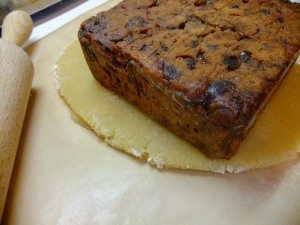
Covering the cake in almond paste
- Give the cake a thump to make sure it sticks and then cut around the edge. If the cake is a little “round shouldered”, cut the almond paste a little larger.
- With a palette knife press the extra almond paste in against the top of the cake to fill any gaps.
- Measure the circumference of the cake with a piece of string. Roll out 2 long strips of almond paste to half that length: trim both edges to the height of the cake with a palette knife.
- Brush both the cake and the almond paste lightly with egg white. Press the strip against the sides of the cake: do not overlap or there will be a bulge. Use a straight-sided glass to even the edges and smooth the join.
- Rub the cake well with your hand to ensure a nice flat surface. Keep any leftover almond paste keep for later to make chocolate-dipped marzipan balls with (to be posted in the next few weeks!).
- Let the marzipan dry out for at least 2 days before icing the cake as normal (we don’t even eat the icing, we just break it off and eat the rest, but it looks great!)
Why this cake is better for you:
Macadamia nut oil is used for this delicious cake as it can be cooked at temperatures up to 200C without producing harmful trans fats. Trans fats are contained in all polyunsaturated supermarket oils and in any polyunsaturated oils that have been heated. Damaged (trans) fats damage and age your body. So if you want to have great skin, a healthy heart, and tip top digestion, it’s a good idea to phase them out of your diet. Ready meals, takeaways, most cooking oils, and shop-bought biscuits and confectionery are sources of trans fats. The 2 oils that are best for cooking are virgin coconut oil and virgin macadamia oil. Most other oils should be eaten cold-pressed and raw. Extra virgin oil can be added to stews and soups, or to finished dishes, provided you don’t fry with it. If you want to know more about oils that help your health, read “Fats that heal Fats that kill” by Udo Erasmus (more details on www.annacollins.ie). Unsulphured dried fruit does not use sulphur dioxide, a preservative. Sulphur dioxide is acted upon by sulphur-reducing bacteria in your bowel (if your bowel bacteria is imbalanced) and this can cause bloating, gas or headaches if you are suseptable.
Making marzipan with xylitol instead of almond paste makes it kind to your teeth. Xylitol inhibits the bacteria that cause tooth decay from sticking to your teeth. Xylitol is also lower GI than sugar, so is kinder to your body.

Nov 20, 2013 | Anna's Best Recipes, Cakes, biscuits & bars, Desserts & drinks
Don’t know about you but I’m really looking forward to Christmas and have started my baking already. This recipe is the nicest mincemeat and doesn’t boil over during baking. It’s adapted from Rose Cousin’s “Cooking Without” recipe book for people avoiding gluten or dairy. But I’ve been making it for years because I love it. Store this mincemeat in a sterile glass jar. If you intend to store for more than a couple of weeks, allow the mincemeat to cool a little before adding a tablespoon of brandy/whiskey. Mix well just before bottling. You can sterilise jars by boiling the lids in water and heating the jars themselves to around 80C in the oven for 15 minutes.
Organic where possible:
450g peeled cored eating (not cooking) apples – Cox’s are fantastic for flavour
225g unsulphured sultanas
225g unsulphured raisins
110g dried mixed peel (if you avoid citrus, or want to 100% avoid the refined sugar in the peel, use currants or chopped unsulphured apricots instead.
Rind and juice of 1 orange, organic is possible (if avoiding citrus, use apple juice instead)
¼ teaspoon allspice
Level tsp Ceylon cinnamon
1/2 level tsp nutmeg
A little cloudy apple juice
1. Mix together all the ingredients in a large cooking pot with lid
2. Simmer very gently ½ hour
Pastry recipes:
This one’s dairy free, gluten-free https://www.annacollins.ie/gorgeous-gluten-free-mince-pies/
This gluten-free one is made with butter https://www.annacollins.ie/fantastic-buttery-gluten-free-pastry-for-pies-tarts-and-mince-pies/. If you are sensitive to dairy products then you can use clarified butter for the pastry. Make this by very gently heating the butter, skim off the foam on the top and chill in a tall drinking glass or jug, then allow to solidify. You will use only the solid part to make your pastry. Discard the white iquid part underneath – that’s where the problematic milk proteins (which provoke the reaction) are found.
When baking your mince pies
Bake 20-25 mins at 200C (185C fan) until golden
You can use an egg wash to stick the pastry tops on the pies.
Put a baking tray over the next rack in the oven so the pies cook evenly through.
Why this is (somewhat) better for you:
While I’d love to say this is a health-giving recipe I can’t really because its very high in natural sugars. Although it doesn’t contain refined sugar it IS very high in natural sugars from the dried fruit. BUT this mincemeat is free of low grade oils (like vegetable suet or sunflower oil) and refined sugar – both of which fire up inflammation in you. If you choose organic dried fruit you avoid sulphur dioxide (preservative) that wreaks havoc on so many peoples digestion around Christmas time. This preservative is converted by pathogenic bacteria in your bowel into irritating sulphites, which can cause gas, bloating and general unwellness in your gut. Non-organic grapes (raisins etc) are also very heavily contaminated with herbicides such a glyphosate that cause your gut to leak toxins and undigested food into your bloodstream.(increased intestinal permeability and systemic inflammation). This process predisposes to and perpetuates inflammatory conditions from autoimmunity to mood issues and many more besides. Choosing food free of undesirable contaminants is a great step towards better health. Here’s to a happy and a healthy Christmas. I will certainly be eating some (gluten-free) mince pies…

Sep 18, 2013 | Anna's Best Recipes, Cakes, biscuits & bars, Desserts & drinks
These are like a cross between a cake and a flapjack and are great for lunchboxes if you feel the need to put baked treats in. You can also eat them warm, topped with a dollop of natural coconut yoghurt or (for dairy) Greek sheep’s yoghurt with a few drops of vanilla extract stirred in. For these, I adapted Theodora Fitzgibbon’s apple flakemeal layer cake recipe into a traybake and swapped butter for virgin coconut oil.
Makes 16 squares
For unusual ingredients, see “larder & shopping”.
325g cooking apples
1 rounded tsp ground cinnamon
A generous pinch of nutmeg, if you have it
30g raisins
50g virgin coconut oil (or butter, if you eat dairy)
1½ rounded tbs rounded tbs honey
1 rounded dsp blackstrap molasses
175g gluten-free porridge oats (or normal if you eat gluten)
Grated rind of an organic lemon (if you cant get organic, scrub in hot water before using)
Juice ½ lemon
1 egg
- Turn on the oven to 180C (165C fan).
- Line a 20-20cm baking tray or brownie tin with greased baking paper.
- In a large saucepan on a very low heat gently melt the honey, molasses and coconut oil. A tip for getting the honey or molasses easily off the spoon is to heat the spoon first in a jug of boiling water.
- Meanwhile chop the raisins, peel and grate the apples and mix everything together with the lemon juice and rind. The antioxidants in the lemon prevent the apples turning brown. When the oil and honey mixture is melted, add the oats, cinnamon, nutmeg, apple mixture to the saucepan and mix to combine. Finally, beat the egg, add in and mix lightly.
- Turn the mixture into the prepared tin, even out and smooth down with a knife or spatula and bake, checking after about 20 minutes. It should take around 30 minutes and be only very slightly browned on top and at the edges. It will still be moist and a little springy to the touch.
Why this recipe is better for you:
Virgin coconut oil is a healthy oil rich in medium chain triglycerides that help increase energy levels in your body and brain rather than being stored as fat in your body. Cooking apples are a very rich source of pectin, which binds to toxic materials in the bowel until they can be eliminated safely. Both apples and oats contain soluble fibre which nourishes beneficial bacteria in the gut. Beneficial bacteria help support immunity, clear skin and regulate bowel function. Honey, molasses and almost all other sweeteners are still high in natural sugars so if you want the ideal diet, aim not to eat them more than a couple of times a week. For transitioning from a high sugar to a low sugar diet though, these are ideal. Molasses is high in iron and chromium so it does have some benefits as well as its lovely toffee flavour. Stevia is the only exception to this as it contains no sugars at all and is 100% healthy.

Sep 4, 2013 | Anna's Best Recipes, Cakes, biscuits & bars, Sides, starters, soups & snacks
I adapted this recipe by Xanthe Clay and the result was lovely – and easy to make. They are cooked in a frying pan rather than an oven, stick together really well and have a slight crunch. Unlike “normal” sugar, molasses is unrefined so still contains many nutrients. It has a sort of toffee flavour and can be a great choice for kids as it’s high in iron. Using the sunflower and pumpkin seeds raw at the end rather than toasting them on the pan will increase the nutritional value of the bars further but there will be a bit less crunch. Use organic ingredients where possible. Delicious as a snack or lunchbox filler.
Makes 24 small squares
25g gluten-free porridge oats* (or use normal porridge oats if you can eat gluten)
85g virgin coconut oil
55g sesame seeds
55g sunflower seeds
55g pumpkin seeds
85g dried chopped unsulphured* apricots, blueberries, raisins or sultanas
85g raw cane molasses
* Check out my “larder & shopping” section for where to buy all unusual ingredients
1. Line a baking tin around 27x18cm with silicone/baking paper cut to size
2. Heat a large frying pan and add the oats, sesame seeds, sunflower seeds and pumpkin seeds. Cook for about 10 minutes, stirring often at the beginning but more or less continuously toward the end to stop the mix burning. Its ready when you can hear the sesame seeds starting to pop and see the oats beginning to turn golden.
3. Tip into a ceramic or metal bowl or saucepan to cool and mix in the dried fruit.
4. Put the coconut oil with the molasses or honey in a saucepan. Heat the pan gently until the butter/coconut oil melts – do not allow to bubble.
5. Pour contents of the pan into the oat mixture. Stir until all the dry ingredients are well coated.
6. Tip the mix into the tin. Press down very firmly (it helps to put another sheet of non-stick parchment on tip). Allow to cool and then cut into 24 small squares or rectangles. Store in an airtight container for up to 10 days. After that, they tend to soften but can be firmed up by putting them on a baking sheet in the oven set to 160C and cooking for 15 minutes.
Why this is better for you:
If you are starting to convert your children (or yourself) from a high sugar diet then over time you can reduce the quantity of molasses or other sweetening you use in home baking. Cravings for very sweet foods are caused by mineral and vitamin deficiencies. As these are addressed, people start to be able to taste and enjoy foods which are less sweet. Oats are a much better choice than wheat if you want to avoid upsetting blood sugar balance as oat fibre slows digestion down, keeping you fuller for longer. Nuts/seeds also help delay the release of sugars (from grains, fruit and molasses) into the bloodstream. This helps balance blood sugar levels to help energy levels, brain function and immunity. This recipe is free of harmful refined vegetable oils. Virgin coconut oil is a useful source of medium chain triglycerides , that are used by the body directly to make energy instead of being stored as fat. The oils in the sesame seeds, although damaged by heating, cannot be absorbed by the body as whole sesame seeds are not digested (they are too small so pass through and out the other end intact!). As I mentioned before, you could avoid adding the pumpkin seeds and sunflower seeds until the end to boost the nutritional value of these bars further. Raw nuts and seeds contain beneficial omega 6 oils.

Aug 23, 2013 | Anna's Best Recipes, Cakes, biscuits & bars
This is a pretty easy and deliciously moist cake which I made last weekend. Serve as an afternoon tea cake or as a dessert with a fresh orange and blueberry fruit salad and/or (if you eat dairy) a blob of natural Greek yoghurt.
For one 23cm round cake to serve 6-8
2 medium oranges – organic and unwaxed
3 eggs, separated
120g Xylitol
150g ground almonds
1 level tsp gluten-free, aluminum-free baking powder
Check out my “larder & shopping” section for where to buy unusual ingredients
1. Place the clean, whole, and unpeeled oranges in a pan with enough water to cover. Bring to the boil, cover with a lid and simmer for about one and a half hours or until soft, adding more water if necessary (you can do this in a pressure cooker in half the time – just half cover the fruit with water).
2. Drain the oranges and cut them into quarters, discarding any major pips. Put the orange pieces, including the peel, in the food processor and blend to a pulp. Leave to cool.
3. Beat the egg yolks and the xylitol in a large bowl until light and fluffy. Beat in the orange pulp, almond, and baking powder. In a separate bowl, beat the egg whites until they form soft peaks, then gently fold into the orange mixture.
4. Preheat the oven to 175C/160 fan/gas 4. Lightly oil and line a 23cm round loose-bottomed cake tin or rectangular loaf tin with greaseproof paper.
5. Bake for an hour, until golden and firm to the touch. Turn out carefully and store in an airtight container in the fridge for up to 5 days.
Why this recipe is better for you:
Foods cooked at over 120C are less good for you than foods cooked at low temperatures. However, this cake is still better for your body than most bakery goods which contain toxic refined oils, sugar and white flour. Because the cake contains protein from the almonds, it’s low GI. This means it won’t upset blood sugar levels and cause fluctuations in energy or mood or stress levels. Xylitol is a tooth-friendly and healthier alternative to sugar. Because non-organic oranges are covered in pesticides and chemical-containing preservative waxes, their skins contain harmful chemicals. Boiling the fruit and discarding this water should make the skins safer to eat. The ground almonds in this cake do not count towards your daily intake of healthy, raw omega 6 oils as they have been heated to a high temperature and lose their beneficial properties.


